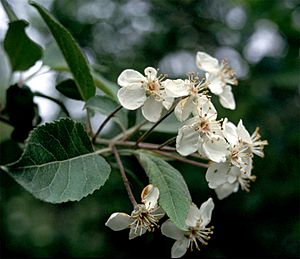Malus fusca facts for kids
Quick facts for kids Malus fusca |
|
|---|---|
 |
|
| Malus fusca flowers and leaves, at Humboldt Bay National Wildlife Refuge in California |
|
| Conservation status | |
| Scientific classification | |
| Synonyms | |
|
Synonymy
Malus diversifolia (Bong.) M.Roem.
Malus fusca var. levipes (Nutt.) C.K.Schneid. Malus rivularis (Douglas ex Hook.) M.Roem. Pyrus diversifolia Bong. Pyrus fusca Raf. 1830 Pyrus fusea Raf. Pyrus rivularis Douglas ex Hook. Pyrus rivularis var. levipes Nutt. Sorbus rivularis (Douglas ex Hook.) H.Hara |
The Malus fusca, also known as the Oregon crabapple or Pacific crabapple, is a type of crabapple tree. It is native to North America. This tree is part of the rose family.
Contents
Where the Pacific Crabapple Grows
This special tree grows naturally in western North America. You can find it from Alaska all the way down through British Columbia in Canada. It also grows into northwestern California in the United States. It likes to live in cool, wet temperate coniferous forests. These forests are mainly found in the Cascade Range and the Pacific Coast Ranges.
What the Oregon Crabapple Looks Like
The Malus fusca is a deciduous tree. This means it loses its leaves every autumn. It can grow quite tall, sometimes up to 13 meters (about 43 feet) high. Its leaves can be up to 10 centimeters (about 4 inches) long.
Flowers and Fruit
In the spring, the tree blooms with beautiful white or pale pink flowers. After the flowers, small, round fruits grow. These fruits are like tiny apples. They can be red, yellow, or a mix of yellow and green. These small fruits are called pomes.
Uses of the Pacific Crabapple
Even though the fruit of the Pacific crabapple is quite sour, people can still eat it. It's often used to make jams and jellies. The fruit is also rich in pectin. Pectin is a natural substance that helps jams and jellies set and become thick.
Traditional Uses by Indigenous Peoples
For many years, the Indigenous peoples of the Pacific Northwest valued the Pacific crabapple. They gathered the fruits along the coast as an important food source. The tree was also used for its strong wood. This wood was great for making tools and other items.
The bark of the tree was also very useful. It was used in traditional medicine. People would make special drinks from the bark or fruit. These drinks were used for things like upset stomachs or skin problems. They also helped with eye infections and to ease pain.
Images for kids
See also
 In Spanish: Malus fusca para niños
In Spanish: Malus fusca para niños


